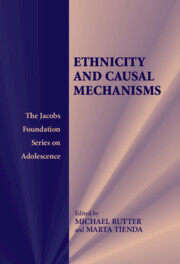Book contents
- Frontmatter
- Contents
- List of Contributors
- Foreword
- Preface
- 1 Natural Experiments, Causal Influences, and Policy Development
- 2 Growing Up Ethnic in the United Kingdom and the United States: Comparative Contexts for Youth Development
- 3 The Multiple Facets of Ethnicity
- 4 Educational Attainments: Ethnic Differences in the United Kingdom
- 5 Race and Ethnic Inequality in Educational Attainment in the United States
- 6 Racial and Ethnic Disparities in Crime and Delinquency in the United States
- 7 Explaining Ethnic Variations in Crime and Antisocial Behavior in the United Kingdom
- 8 Cultural Differences in the Effects of Physical Punishment
- 9 Ethnicity and Mental Health: The Example of Schizophrenia in the African-Caribbean Population in Europe
- 10 Ethnic Variations in Youth Suicide
- 11 Ethnicity and Intergenerational Identities and Adaptations in Britain: The Socio-Political Context
- 12 Assimilation, Dissimilation, and Ethnic Identities: The Experience of Children of Immigrants in the United States
- 13 Deciphering Ethnicity: Reflections on Research Opportunities
- Author Index
- Subject Index
6 - Racial and Ethnic Disparities in Crime and Delinquency in the United States
Published online by Cambridge University Press: 05 July 2014
- Frontmatter
- Contents
- List of Contributors
- Foreword
- Preface
- 1 Natural Experiments, Causal Influences, and Policy Development
- 2 Growing Up Ethnic in the United Kingdom and the United States: Comparative Contexts for Youth Development
- 3 The Multiple Facets of Ethnicity
- 4 Educational Attainments: Ethnic Differences in the United Kingdom
- 5 Race and Ethnic Inequality in Educational Attainment in the United States
- 6 Racial and Ethnic Disparities in Crime and Delinquency in the United States
- 7 Explaining Ethnic Variations in Crime and Antisocial Behavior in the United Kingdom
- 8 Cultural Differences in the Effects of Physical Punishment
- 9 Ethnicity and Mental Health: The Example of Schizophrenia in the African-Caribbean Population in Europe
- 10 Ethnic Variations in Youth Suicide
- 11 Ethnicity and Intergenerational Identities and Adaptations in Britain: The Socio-Political Context
- 12 Assimilation, Dissimilation, and Ethnic Identities: The Experience of Children of Immigrants in the United States
- 13 Deciphering Ethnicity: Reflections on Research Opportunities
- Author Index
- Subject Index
Summary
Racial and ethnic disparities in the United States criminal justice system are large and persistent. Prison statistics indicate that 28 percent of African American males and 16 percent of Hispanic males will be sent to prison in their lifetime, compared with only 4.4 percent of White males, and that Black and Hispanic minority groups made up 64 percent of the U.S. prison inmate population in 2001 (Bonczar & Beck, 1997). Police statistics showed that in 2000, African Americans were 6 times more likely than Whites to be murdered and 7 times more likely to commit homicides (Fox & Zawitz, 2003). Such stark racial and ethnic disparities polarize researchers and commentators into two opposing camps: those who think that the overrepresentation of racial and ethnic minorities in the criminal justice system is a reflection of group differences in criminal offending, and those who argue that the disparities in official statistics (e.g., rates of arrest, conviction, incarceration) reflect persistent biases among decision-makers in the criminal justice system (McCord, Widom, & Crowell, 2001; Tonry, 1995; Zimring & Hawkins, 1997). One casualty of this debate is the advancement of criminological research on the fundamental sources of racial and ethnic differences in criminal and delinquent behavior (McCord et al., 2001).
This paper reviews the key empirical findings on race, ethnicity, and criminal/delinquent behavior in the United States.
- Type
- Chapter
- Information
- Ethnicity and Causal Mechanisms , pp. 139 - 173Publisher: Cambridge University PressPrint publication year: 2005
- 37
- Cited by



